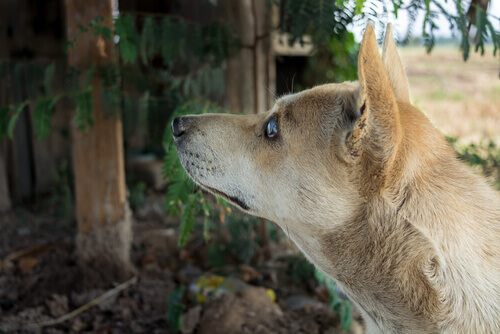Treatments for Blindness in Dogs: Alternatives

Surely the sense of smell is the most useful and best-developed sense that dogs have. They use their noses to look for traces, identify other dogs or animals, find food, among other things. However, this doesn’t mean their sense of sight is less important and this makes blindness in dogs a considerable handicap. In this article, we’ll discuss possible treatments for a blind dog.
It’s true that the sense of sight represents a more vital sense for us as humans. However, this doesn’t mean that it doesn’t play an important role in a dog’s development and daily life.
There are many possible conditions that can lead to, and trigger, a loss of sight in these animals. For this reason, treatment will always be geared towards treating the primary cause. Let’s explain and delve into some of the most common causes and their corresponding treatments.
How to recognize blindness in dogs
First and foremost, we need to learn about some aspects that we should take into account as pet owners to detect possible blindness in our pets.
Normally, in the absence of acute pathologies associated with them, these processes tend to have a degenerative and progressive nature. As a result, it can sometimes be difficult to recognize vision loss in our dogs early on. Here are some possible clues to keep in mind:
- The dog can start behaving uneasily, and be easily frightened. It may become shy or aggressive, depending on the dog’s temperament or character. This happens because the dog feels more vulnerable when losing its vision.
- It may crash into objects, especially at night during walks. With lower light intensity and in an unknown environment, the lack of visual acuity manifests itself.
At home, in a familiar environment, the animal has already learned the space by memory and doesn’t usually crash or bump into objects. In this regard, a test to detect vision loss early is to develop a kind of domestic obstacle race for our animal and observe how it behaves.

Possible treatments
Up next, we’ll start by relating the treatment to the associated pathology. In addition, we’ll mention some common problems that cause most cases of blindness in dogs.
Cataract
Undoubtedly, this is the pathology behind most problems of vision loss in dogs. This disease is progressive in nature. An exception to this is the diabetic kind of cataract, which usually has a sharper presentation.
Although there are several topical eye drop-based treatments to slow down the rate at which cataracts progress, the ultimate solution is surgery. Moreover, after assessing the animal’s eye condition, a veterinary ophthalmologist should perform this surgery.
Glaucoma
This is an alteration in the eyeball which consists of an increase in intraocular pressure, with the resultant damage to the optic nerve. There are many causes that can produce this increase in pressure, so the treatment will focus on treating the underlying motive.
There are a number of medical treatments that focus on reducing intraocular pressure. Glaucoma is usually easily treated with eye drops or oral drugs. However, we should mention that, in certain cases, surgical treatment will be necessary.
Corneal opacification
As many of you will know, the cornea is the transparent structure that allows light to enter the eye. Any problem that causes an alteration in this transparency will inevitably lead to blindness in dogs and in humans.
Ulcers, conjunctivitis, or dry eye are some of the diseases that can cause corneal opacification.
Treatment will always focus on maintaining transparency. With the use of topical corticosteroids in eye drops, we can reduce the creation of new blood vessels, which gives opacity to the cornea.
On the other hand, hydrating the eye is of vital importance in these cases, since, in doing so, we can minimize the development of injuries.

Tumors
There are several kinds of tumor processes that can affect the eyeball, both primary and secondary. In addition, these processes must always be properly assessed to identify their nature.
Although the tumors may be of a benign nature, if blindness ensues as a result of tumor development, surgical removal is the treatment of choice. This is especially true in the case of tumors that are the result of a predicted disease.
However, particularly in the case of primary tumors, these usually only affect one of the eyes.
Early detection is the best solution
As we’ve seen, blindness in dogs is a rare pathology that requires the pet owner to keep a careful watch on their pet.
The causes are diverse, but the main solution is early detection of the problem through professional help. Your trusted veterinarian will guide you on what to do and what to expect of this pathology in your pet, as well as indicating all the possible treatments available.
